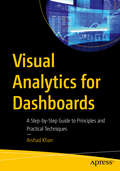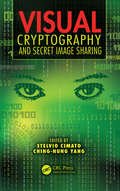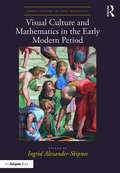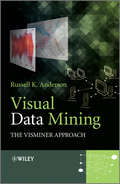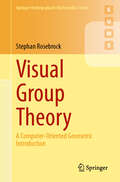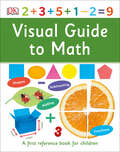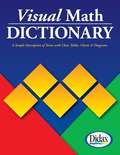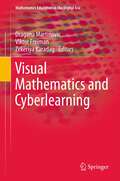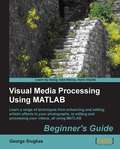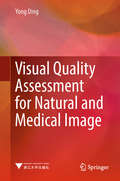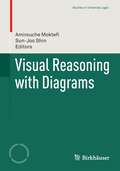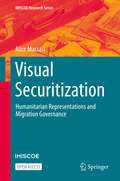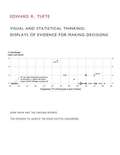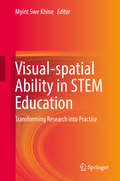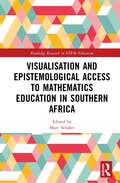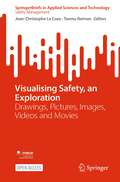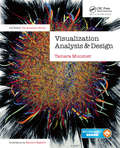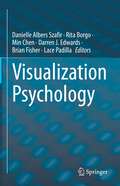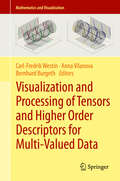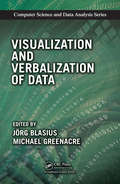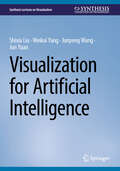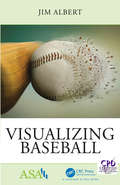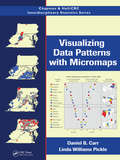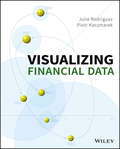- Table View
- List View
Visual Analytics for Dashboards: A Step-by-Step Guide to Principles and Practical Techniques
by Arshad KhanThis book covers the key principles, best practices, and practical techniques for designing and implementing visually compelling dashboards. It explores the various stages of the dashboard development process, from understanding user needs and defining goals, to selecting appropriate visual encodings, designing effective layouts, and employing interactive elements. It also addresses the critical aspect of data storytelling, examining how narratives and context can be woven into dashboards to deliver impactful insights and engage audiences. Visual Analytics for Dashboards is designed to cater to a wide range of readers, from beginners looking to grasp the fundamentals of visual analytics, to seasoned professionals seeking to enhance their dashboard design skills. For different types of readers, such as a data analyst, BI professional, data scientist, or simply someone interested in data visualization, this book aims to equip them with the knowledge and tools necessary to create impactful dashboards. What you’ll learn The principles of data visualization How to create effective dashboards Meet all the requirements for visual analytics/data visualization/dashboard courses Deepen understanding of data presentation and analysis How to use different kinds of tools for data analysis, such as scorecards and key performance indicators Who This Book Is For Business analysts, data analysts, BI professionals, end-users, executives, developers, as well as students in dashboards, data visualizations, and visual analytics courses.
Visual Cryptography and Secret Image Sharing
by Ching-Nung Yang Stelvio CimatoWith rapid progress in Internet and digital imaging technology, there are more and more ways to easily create, publish, and distribute images. Considered the first book to focus on the relationship between digital imaging and privacy protection, Visual Cryptography and Secret Image Sharing is a complete introduction to novel security methods and sharing-control mechanisms used to protect against unauthorized data access and secure dissemination of sensitive information. Image data protection and image-based authentication techniques offer efficient solutions for controlling how private data and images are made available only to select people. Essential to the design of systems used to manage images that contain sensitive data—such as medical records, financial transactions, and electronic voting systems—the methods presented in this book are useful to counter traditional encryption techniques, which do not scale well and are less efficient when applied directly to image files. An exploration of the most prominent topics in digital imaging security, this book discusses: Potential for sharing multiple secrets, Visual cryptography schemes—based either on the probabilistic reconstruction of the secret image, or on different logical operations for combining shared images, Inclusion of pictures in the distributed shares, Contrast enhancement techniques, Color-image visual cryptography, Cheating prevention, Alignment problems for image shares, Steganography and authentication In the continually evolving world of secure image sharing, a growing number of people are becoming involved as new applications and business models are being developed all the time. This contributed volume gives academicians, researchers, and professionals the insight of well-known experts on key concepts, issues, trends, and technologies in this emerging field.
Visual Culture and Mathematics in the Early Modern Period (Visual Culture in Early Modernity)
by Ingrid Alexander-SkipnesDuring the early modern period there was a natural correspondence between how artists might benefit from the knowledge of mathematics and how mathematicians might explore, through advances in the study of visual culture, new areas of enquiry that would uncover the mysteries of the visible world. This volume makes its contribution by offering new interdisciplinary approaches that not only investigate perspective but also examine how mathematics enriched aesthetic theory and the human mind. The contributors explore the portrayal of mathematical activity and mathematicians as well as their ideas and instruments, how artists displayed their mathematical skills and the choices visual artists made between geometry and arithmetic, as well as Euclid’s impact on drawing, artistic practice and theory. These chapters cover a broad geographical area that includes Italy, Switzerland, Germany, the Netherlands, France and England. The artists, philosophers and mathematicians whose work is discussed include Leon Battista Alberti, Nicholas Cusanus, Marsilio Ficino, Francesco di Giorgio, Leonardo da Vinci and Andrea del Verrocchio, as well as Michelangelo, Galileo, Piero della Francesca, Girard Desargues, William Hogarth, Albrecht Dürer, Luca Pacioli and Raphael.
Visual Data Mining
by Russell K. AndersonA visual approach to data mining. Data mining has been defined as the search for useful and previously unknown patterns in large datasets, yet when faced with the task of mining a large dataset, it is not always obvious where to start and how to proceed. This book introduces a visual methodology for data mining demonstrating the application of methodology along with a sequence of exercises using VisMiner. VisMiner has been developed by the author and provides a powerful visual data mining tool enabling the reader to see the data that they are working on and to visually evaluate the models created from the data. Key features:Presents visual support for all phases of data mining including dataset preparation.Provides a comprehensive set of non-trivial datasets and problems with accompanying software.Features 3-D visualizations of multi-dimensional datasets.Gives support for spatial data analysis with GIS like features.Describes data mining algorithms with guidance on when and how to use.Accompanied by VisMiner, a visual software tool for data mining, developed specifically to bridge the gap between theory and practice.Visual Data Mining: The VisMiner Approach is designed as a hands-on work book to introduce the methodologies to students in data mining, advanced statistics, and business intelligence courses. This book provides a set of tutorials, exercises, and case studies that support students in learning data mining processes.In praise of the VisMiner approach: "What we discovered among students was that the visualization concepts and tools brought the analysis alive in a way that was broadly understood and could be used to make sound decisions with greater certainty about the outcomes"--Dr. James V. Hansen, J. Owen Cherrington Professor, Marriott School, Brigham Young University, USA"Students learn best when they are able to visualize relationships between data and results during the data mining process. VisMiner is easy to learn and yet offers great visualization capabilities throughout the data mining process. My students liked it very much and so did I." --Dr. Douglas Dean, Assoc. Professor of Information Systems, Marriott School, Brigham Young University, USA
Visual Group Theory: A Computer-Oriented Geometric Introduction (Springer Undergraduate Mathematics Series)
by Stephan RosebrockThis textbook provides an introduction to group theory starting from the basics, relying on geometry to elucidate its various aspects. Groups naturally manifest as symmetries of geometric shapes, such as reflections and rotations. The book adopts this perspective to provide a straightforward, descriptive explanation, supported by examples and exercises in GAP, an open-source computer algebra system. It covers all of the key concepts of group theory, including homomorphisms, group operations, presentations, products of groups, and finite, abelian, and solvable groups. The topics include cyclic and symmetric groups, dihedral, orthogonal, and hyperbolic groups, as well as the significant notion of Cayley graphs. Self-contained and requiring little beyond high school mathematics, this book is aimed at undergraduate courses and features numerous exercises. It will also appeal to anyone interested in the geometric approach to group theory.
Visual Guide to Math (DK First Reference)
by DKKey math vocabulary and concepts for young children explained simply in this friendly and informative reference book.Clear, accessible pictures and diagrams support this first introduction to numbers, calculating, measuring, geometry, and data-collecting, making basic maths skills easier to understand. Packed with key terms and useful tips to help remember as well as practical examples of math in daily life, Visual Guide to Math is ideal even for reluctant kids. Place value, number bonds, multiplication tables, and fractions are just a few of the math concepts explained and reinforced in a variety of ways for children with different learning styles.Covering everything a young child needs to know, this unique reference book follows the curriculum and provides a strong foundation for math skills through the rest of the school years. A perfect homework help to support children as they take their first steps in math and build confidence.
Visual Math Dict
by Don Balka Jack BanaThe most accessible and useful guide to math terms and procedures available, this reference has over 600 definitions and scores of additional resources including tables, rules and symbols.
Visual Mathematics and Cyberlearning
by Viktor Freiman Dragana Martinovic Zekeriya KaradagThis first book in the series will describe the Net Generation as visual learners who thrive when surrounded with new technologies and whose needs can be met with the technological innovations. These new learners seek novel ways of studying, such as collaborating with peers, multitasking, as well as use of multimedia, the Internet, and other Information and Communication Technologies. Here we present mathematics as a contemporary subject that is engaging, exciting and enlightening in new ways. For example, in the distributed environment of cyber space, mathematics learners play games, watch presentations on YouTube, create Java applets of mathematics simulations and exchange thoughts over the Instant Messaging tool. How should mathematics education resonate with these learners and technological novelties that excite them?
Visual Media Processing Using Matlab Beginner's Guide
by George SiogkasWritten in a friendly, Beginner's Guide format, showing the user how to use the digital media aspects of Matlab (image, video, sound) in a practical, tutorial-based style.This is great for novice programmers in any language who would like to use Matlab as a tool for their image and video processing needs, and also comes in handy for photographers or video editors with even less programming experience wanting to find an all-in-one tool for their tasks.
Visual Quality Assessment for Natural and Medical Image
by Yong DingImage quality assessment (IQA) is an essential technique in the design of modern, large-scale image and video processing systems. This book introduces and discusses in detail topics related to IQA, including the basic principles of subjective and objective experiments, biological evidence for image quality perception, and recent research developments. In line with recent trends in imaging techniques and to explain the application-specific utilization, it particularly focuses on IQA for stereoscopic (3D) images and medical images, rather than on planar (2D) natural images. In addition, a wealth of vivid, specific figures and formulas help readers deepen their understanding of fundamental and new applications for image quality assessment technology. This book is suitable for researchers, clinicians and engineers as well as students working in related disciplines, including imaging, displaying, image processing, and storage and transmission. By reviewing and presenting the latest advances, and new trends and challenges in the field, it benefits researchers and industrial R&D engineers seeking to implement image quality assessment systems for specific applications or design/optimize image/video processing algorithms.
Visual Reasoning with Diagrams
by Sun-Joo Shin Amirouche MoktefiLogic, the discipline that explores valid reasoning, does not need to be limited to a specific form of representation but should include any form as long as it allows us to draw sound conclusions from given information. The use of diagrams has a long but unequal history in logic: The golden age of diagrammatic logic of the 19th century thanks to Euler and Venn diagrams was followed by the early 20th century's symbolization of modern logic by Frege and Russell. Recently, we have been witnessing a revival of interest in diagrams from various disciplines - mathematics, logic, philosophy, cognitive science, and computer science. This book aims to provide a space for this newly debated topic - the logical status of diagrams - in order to advance the goal of universal logic by exploring common and/or unique features of visual reasoning.
Visual Securitization: Humanitarian Representations and Migration Governance (IMISCOE Research Series)
by Alice MassariThis open access book offers an innovative account of how relief organizations’ visual depiction of Syrian displacement contributes to reproduce and reinforce a securitized account of refugees. Through visual analysis, the book demonstrates how the securitization process takes place in three different ways. First of all, even if marginally, it occurs through the reproduction of mainstream media and political accounts that have depicted refugees in terms of threats. Secondly, and more consistently, through a representation of Syrian displaced people that, despite the undeniable innovative aesthetic patterns focusing on dignity and empowerment, continue to reinforce a visual narrative around refugees in terms of victimhood and passivity. The reproduction of a securitized account takes also place through the dialectic between what is made visible in the pictures and what is not. At the same time the book identifies visual glimmers and minor displacements in the humanitarian discourse that have the potentiality to produce alternative discourses on refugees and displacement beyond the mainstream securitized ones. By showing how relief organizations’ visual representation contributes to the securitization of the refugee issue, this book provides a great resource to students and academics in migration, visuality, humanitarianism and securitization, as well as social scientists and policy-makers.
Visual and Statistical Thinking: Displays of Evidence for Deicision Making
by Edward R. TufteThis booklet meant for students of quantitative thinking, reproduces chapter 2 of his other book Visual Explanations, Here we see two complex cases of the analysis and display of evidence--the celebrated investigation of a cholera epidemic by Dr. John Snow and the unfortunate decision to launch the space shuttle Challenger.
Visual-spatial Ability in STEM Education
by Myint Swe KhineEach chapter in this book makes a unique contribution to the body of the literature and enhances the understanding of spatial ability and its influence on learning in the STEM disciplines. It addresses spatial abilities, ways to measure them as well as their impact and how they can affect learning subjects in scientific, technology and engineering domains. The volume deliberately covers a wide range perspectives from cognitive psychology, educational psychology, science, technology, engineering and mathematics, computer science, information technology disciplines to human development. Taking a broad view on the topic, chapters in the book discuss how to define spatial ability and its factors, the measurement of spatial ability and psychometric analyses, and educational strategies to improve spatial skills and their implications for science and technology education. The book thus provides an overview of current thinking about visual-spatial ability, spatial reasoning, and spatial skills.
Visualisation and Epistemological Access to Mathematics Education in Southern Africa (Routledge Research in STEM Education)
by Marc SchäferThis book demonstrates that using visualisation processes in mathematics education can help to enhance teaching and learning and bridge the inequality gap that exists between well-resourced and under-resourced schools in Southern Africa. Drawing on classroom research conducted in the Southern African region, it examines how epistemological access in a context of gross inequality can be constructively addressed by providing research-based solutions and recommendations. The book outlines the visualisation process as an integral but often overlooked process of mathematics teaching and learning. It goes beyond the traditional understanding of visualisation processes such as picture forming and using tools and considers visualisation processes that are semiotic in nature and includes actions such as gestures in combination with language. It adds value to the visualisation in mathematics education research discourse and deliberation in Africa. With a unique focus on Southern Africa and open avenues for further research and collaboration in the region, it will be a highly relevant reading for researchers, academics and post-graduate students of mathematics education, comparative education and social justice education.
Visualising Safety, an Exploration: Drawings, Pictures, Images, Videos and Movies (SpringerBriefs in Applied Sciences and Technology)
by Jean-Christophe Le Coze Teemu ReimanThis open access book explores the role visual tools and graphical models play in safety management. It explains the importance of visualising safety, for teaching concepts, communicating ideas to peers, and raising awareness of potential threats through posters. Visualising Safety, an Exploration introduces graphical models which have been influential in promoting ideas of safety, and impacting the organisational design of safety mechanisms, including the Heinreich ‘safety pyramid’ and Reason’s ‘Swiss Cheese’. It analyses these models, as well as other forms of visualization, presenting viewpoints from academics and practitioners in the fields of safety science, history, ethnography and interface design.This brief will be of interest to anyone working in the field of safety management and design, including researchers, managers and students.
Visualization Analysis and Design (Ak Peters Visualization Ser.)
by Tamara MunznerLearn How to Design Effective Visualization SystemsVisualization Analysis and Design provides a systematic, comprehensive framework for thinking about visualization in terms of principles and design choices. The book features a unified approach encompassing information visualization techniques for abstract data, scientific visualization techniques
Visualization Psychology
by Min Chen Brian Fisher Darren J. Edwards Danielle Albers Szafir Rita Borgo Lace PadillaThis book designates Visualization Psychology as an interdisciplinary subject. The book contains literature reviews and experimental works that exemplify a range of open questions at this critical intersection. It also includes discourses that envision how the subject may be developed in the coming years and decades. The field of visualization is a rich playground for discovering new knowledge in both visualization and psychology. As visualization techniques augment human cognition, these techniques must be developed and improved by building on theoretical, empirical and methodological knowledge from psychology. At the same time, visualization processes surface numerous phenomena about interactions between the human mind and digital entities, such as data, visual imagery, algorithms, and computer-generated predictions and recommendations. Visualization psychology is a new type of science in the making.
Visualization and Imputation of Missing Values: With Applications in R (Statistics and Computing)
by Matthias TemplThis book explores visualization and imputation techniques for missing values and presents practical applications using the statistical software R. It explains the concepts of common imputation methods with a focus on visualization, description of data problems and practical solutions using R, including modern methods of robust imputation, imputation based on deep learning and imputation for complex data. By describing the advantages, disadvantages and pitfalls of each method, the book presents a clear picture of which imputation methods are applicable given a specific data set at hand.The material covered includes the pre-analysis of data, visualization of missing values in incomplete data, single and multiple imputation, deductive imputation and outlier replacement, model-based methods including methods based on robust estimates, non-linear methods such as tree-based and deep learning methods, imputation of compositional data, imputation quality evaluation from visual diagnostics to precision measures, coverage rates and prediction performance and a description of different model- and design-based simulation designs for the evaluation. The book also features a topic-focused introduction to R and R code is provided in each chapter to explain the practical application of the described methodology. Addressed to researchers, practitioners and students who work with incomplete data, the book offers an introduction to the subject as well as a discussion of recent developments in the field. It is suitable for beginners to the topic and advanced readers alike.
Visualization and Processing of Tensors and Higher Order Descriptors for Multi-Valued Data
by Carl-Fredrik Westin Anna Vilanova Bernhard BurgethArising from the fourth Dagstuhl conference entitled Visualization and Processing of Tensors and Higher Order Descriptors for Multi-Valued Data (2011), this book offers a broad and vivid view of current work in this emerging field. Topics covered range from applications of the analysis of tensor fields to research on their mathematical and analytical properties. Part I, Tensor Data Visualization, surveys techniques for visualization of tensors and tensor fields in engineering, discusses the current state of the art and challenges, and examines tensor invariants and glyph design, including an overview of common glyphs. The second Part, Representation and Processing of Higher-order Descriptors, describes a matrix representation of local phase, outlines mathematical morphological operations techniques, extended for use in vector images, and generalizes erosion to the space of diffusion weighted MRI. Part III, Higher Order Tensors and Riemannian-Finsler Geometry, offers powerful mathematical language to model and analyze large and complex diffusion data such as High Angular Resolution Diffusion Imaging (HARDI) and Diffusion Kurtosis Imaging (DKI). A Part entitled Tensor Signal Processing presents new methods for processing tensor-valued data, including a novel perspective on performing voxel-wise morphometry of diffusion tensor data using kernel-based approach, explores the free-water diffusion model, and reviews proposed approaches for computing fabric tensors, emphasizing trabecular bone research. The last Part, Applications of Tensor Processing, discusses metric and curvature tensors, two of the most studied tensors in geometry processing. Also covered is a technique for diagnostic prediction of first-episode schizophrenia patients based on brain diffusion MRI data. The last chapter presents an interactive system integrating the visual analysis of diffusion MRI tractography with data from electroencephalography.
Visualization and Verbalization of Data (Chapman & Hall/CRC Computer Science & Data Analysis)
by Michael Greenacre Jörg BlasiusVisualization and Verbalization of Data shows how correspondence analysis and related techniques enable the display of data in graphical form, which results in the verbalization of the structures in data. Renowned researchers in the field trace the history of these techniques and cover their current applications.The first part of the book explains
Visualization for Artificial Intelligence (Synthesis Lectures on Visualization)
by Jun Yuan Shixia Liu Weikai Yang Junpeng WangThis book explores how visualization provides an effective way of improving not only the interpretability but also the generalization capabilities of machine learning models. It shows how visualization can bridge the gap between complex models or algorithms and human understanding while also facilitating data curation and model refinement. Therefore, visualization for artificial intelligence (VIS4AI) has become an emerging area that combines interactive visualization with machine learning techniques to maximize their values. VIS4AI techniques focus on every phase of the machine learning life cycle, from data preprocessing to model development and deployment. These techniques are closely aligned with the well-established data and model pipelines in machine learning. In the data pipeline, they contribute to improving data quality and feature quality, including training data cleaning and feature engineering. In the model pipeline, they support (1) model development by focusing on model understanding, diagnosis, and steering; and (2) model deployment by enabling decision explanation, model performance monitoring, and model maintenance. This book provides a framework of VIS4AI and introduces the associated techniques in the two pipelines. It emphasizes the importance of interactive visualization in AI and presents various visualization techniques for different purposes. It also discusses the challenges and opportunities of VIS4AI and proposes several promising research topics for future work, such as improving training data using complementary modalities, online training diagnosis, fitting the dynamic nature of AI systems, and interactively pre-training and adapting foundation models. Overall, this book aims to serve as a resource for researchers and practitioners interested in both visualization and artificial intelligence.
Visualizing Baseball (ASA-CRC Series on Statistical Reasoning in Science and Society)
by Jim AlbertVisualizing Baseball provides a visual exploration of the game of baseball. Graphical displays are used to show how measures of performance, at the team level and the individual level, have changed over the history of baseball. Graphs of career trajectories are helpful for understanding the rise and fall of individual performances of hitters and pitchers over time. One can measure the contribution of plays by the notion of runs expectancy. Graphs of runs expectancy are useful for understanding the importance of the game situation defined by the runners on base and number of outs. Also the runs measure can be used to quantify hitter and pitch counts and the win probabilities can be used to define the exciting plays during a baseball game. Special graphs are used to describe pitch data from the PitchFX system and batted ball data from the Statcast system. One can explore patterns of streaky performance and clutch play by the use of graphs, and special plots are used to predict final season batting averages based on data from the middle of the season. This book was written for several types of readers. Many baseball fans should be interested in the topics of the chapters, especially those who are interested in learning more about the quantitative side of baseball. Many statistical ideas are illustrated and so the graphs and accompanying insights can help in promoting statistical literacy at many levels. From a practitioner’s perspective, the chapters offer many illustrations of the use of a modern graphics system and R scripts are available on an accompanying website to reproduce and potentially improve the graphs in this book.
Visualizing Data Patterns with Micromaps (Chapman & Hall/CRC Interdisciplinary Statistics)
by Daniel B. Carr Linda Williams PickleAfter more than 15 years of development drawing on research in cognitive psychology, statistical graphics, computer science, and cartography, micromap designs are becoming part of mainstream statistical visualizations. Bringing together the research of two leaders in this field, Visualizing Data Patterns with Micromaps presents the many design vari
Visualizing Financial Data
by Piotr Kaczmarek Julie RodriguezA fresh take on financial data visualization for greater accuracy and understanding Visualizing Financial Data shows you how to design dynamic, best-of-breed visualizations for better communication of financial data. This book provides a comprehensive set of visualizations tailored to the most common requirements for corporate financial reporting, as well as portfolio, mutual fund, and hedge fund management. This highly visual, full color book showcases a series of cases that push data communication conventions forward, demonstrating and contrasting traditional bar, line, and pie charts against more modern visual methods. The companion website features all of the visualizations discussed, and provides the underlying datasets that you can use to practice on your own or customize the visualizations for your own use. Get a fresh take on visualizations and insight you need to communicate financial data better than ever before. Expand the boundaries of data visualization conventions Optimize data communications, understanding, and disclosure Learn new approaches to traditional charts and visualizations Create exemplary visualizations Visualizing Financial Data shows you newer, better ways of communicating the full meaning of the data, to support efficient, timely, and effective decision-making.
